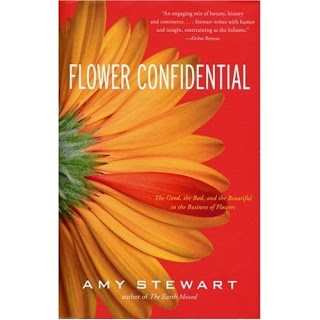It feels appropriate to have finished reading Amy Stewart’s new book, Flower Confidential: The Good, the Bad, and the Beautiful in the Business of Flowers
You’ve heard, “Say it with Flowers.” Amy’s book tells you how to “Say it right with the freshest, hippest, most beautiful and lasting cut flowers that also may happen to have been ecologically raised.”
What I also learned is that cut flowers are incorporated into daily life in some countries. Ahem, Americans, you holiday-focused flower buyers. Live a little dangerously every now and then and buy flowers for your soul, not just the souls you’re obliged to buy for.
After following Amy on this information-packed journey in which she takes a flower’s path from conception (in the hybridizer’s mind) to growth to processing to shipping to marketing and finally to its final destination, you will not only be exhausted for Amy, you will be much more savvy about the freshest, hippest, most meaningful and most extravagent floral offerings in the U.S.; and you’ll know where to get the cheap stuff. Hey, nothing wrong with a budget bouquet… except that it might not last very long and it might have been treated to a pesticide drench. Don’t eat the daisies. Really.
You will also become acquainted with a new form of labeling signifying higher ecological standards. Dare I say “guilt-free” flowers? Amy even touches on a store near you carrying high quality flowers at bargain prices. Any guesses?
Delving into post-harvest flower conditions, Amy tells you how to spot the freshest displays and how to maximize vase life once you get those babies home. You’ll also come to understand why cut flowers can be so danged expensive at times, and you’ll learn about the hidden and not-so-beautiful environmental costs and considerations.
I came away from Flower Confidential with a much keener sense of the business of flowers and a desire to buy organically grown and ecologically managed flowers when given the opportunity. Organic food is becoming mainstream because more people buying it… and more grocers are selling it… because more people are buying it. Now is the time to push the cut flower industry toward organic and Integrated Pest Management (IPM) practices, and toward providing better working conditions and benefits for flower factory workers.
Still, knowing “…the Good, the Bad, and the Beautiful…” about the flower business does nothing to dim the feeling I get when I walk into a florist shop or the floral kiosk at my local grocery store. Pure romance. Pure swoon. And to the flowers? You’ve come a long way, baby. No really. Holland? Ecuador? You look like you could use a drink.
Check out this video snippet of Amy talking about Flower Confidential:
Be sure to catch Amy on her book tour. She may be coming to a bookstore or garden show near you! Read all about it on her blog.




Fascinating! I enjoyed watching the video and your blog has prompted me to look into the new ecological labels. I must admit I had never really thought about the possible environmental impacts of all those flowers we ship around the globe…
Thanks
Thank you for a great review of this book. It is great to know of such a helpful resource of information. I enjoy buying flowers to add a little “everyday enchantement” to my life. I figure they end up costing little more than what I spend in coffee per day at Tim Horton’s.
Hi Angela
Thank you for pointing me towards Amy Stewarts blog.
Even though I have been in Horticulture for nearly 25 years I was unaware of the sheer scale of the cut flower business.
It is huge
Regards
Phil
http://www.landscapejuice.com